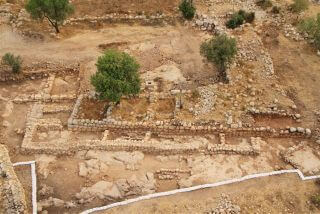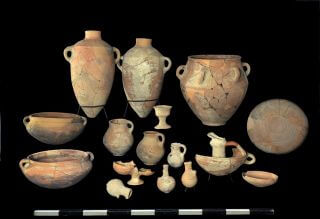In the joint excavation of the Hebrew University and the Antiquities Authority in the ruins of Kiapha, a royal storehouse was also uncovered * these are the two largest buildings known in the tenth century BC in the Kingdom of Judah * in contrast Prof. Finkelstein who published an article about a year ago in which it is claimed that this is an Israeli citadel and not a Jewish one claims that until an inscription is discovered , the various possibilities should not be dismissed

Two state public buildings, the likes of which have not yet been found in the Kingdom of Judah from the 10th century BC, were uncovered during the past year by researchers of the Hebrew University and the Antiquities Authority in the ruins of Kiapha - a fortified city in Judah from the time of King David, which is identified with the biblical Shaareim.
One of the buildings is identified by researchers Prof. Yossi Garfinkel from the Hebrew University and Saar Ganor from the Antiquities Authority as David's Palace, and the other building was used as a huge state warehouse.
Yesterday (Thursday) the excavation, which lasted seven years, comes to an end. According to Prof. Yossi Garfinkel and Saar Ganor, "The ruins of Kyapa are the best example that has been uncovered so far of a fortress city from the time of King David. At the head of the city, the southern part of a large palace was uncovered, the area of which was about 1,000 square meters. The length of the enclosing wall is about 30 meters and has an impressive opening, from which they descended to the southern gate of the city, in front of the Halla Valley. Rooms were found in the perimeter of the palace, in which were various facilities - evidence of metal industry, special pottery and fragments of alabaster stoneware imported from Egypt. The palace is located in the center of the site, and dominates all the city houses below it. From here there is a view of large spaces, from the Mediterranean Sea in the west to the mountains of Hebron and Jerusalem in the east. This is an ideal location for sending messages by lighting beacons. Unfortunately, a large part of this palace was destroyed about 1,400 years later, when in the Byzantine period a fortified farm house was built on the spot."
In the north of the city, a pillared house was uncovered, about 15 m long and 6 m wide, which was used as an administrative building for storage. According to the researchers, "In this structure, the kingdom collected taxes on agricultural produce, which were collected from the residents of the various villages in the Judean Lowlands. Hundreds of large storage jars were found on the site, the handles of which were marked with stamping, as was customary in the Kingdom of Judah for hundreds of years."

The palace and the storehouse are evidence of state construction and administrative organization during the time of King David. "This is clear proof of the existence of a kingdom that knew how to establish control centers at strategic points," say the archaeologists. "Until now, no palaces have been found that can be clearly linked to the beginning of the tenth century BC as it can be done now. The ruins of Kiapha were probably destroyed in one of the battles fought against the Philistines around 980 BC. The palace that has just been uncovered and the fortified city that has been uncovered in recent years are another layer in understanding the beginnings of the Kingdom of Judah."
The discovery of the biblical city in the ruins of Qiafa, and the importance of the findings discovered there, led the Antiquities Authority to act together with RTG and the planning institutions to reject the intention to build a new neighborhood nearby, and to promote the declaration of the areas surrounding the site as a national park.
This plan is based on the understanding that the site will soon become a place that attracts a crowd that will be of great interest, and through which it will be possible to stand for the culture of the land in the days of King David.
Prof. Finkelstein: An important site, an important find, but still does not resolve the territorial debate
Prof. Israel Finkelstein, professor of archeology at Tel Aviv University and co-director of the renewed excavations at the Megiddo site in the north of the country, winner of the 2005 Dan David Prize, says that there is no inscription of any kind in the building, even according to the researchers' findings as published (Prof. Finkelstein excavated the site in the past but He didn't visit it this year, so he didn't see the final reveal for himself, but he knows the site well.
In a conversation with the Hidan website, Prof. Finkelshein says: "There is no doubt that this is an important site from the tenth century BC. The disputes in matters of chronology are not great. The site is unusual in terms of the fortifications and the planning of the settlement which is not seen in any site from this period in the interior parts of the country. Archeology does not say unequivocal things, if you find an inscription like in the situation of Tel Dan, then you know who built the fortifications or who conquered them."
"In the case of Kifa there is no such evidence and therefore the territorial association of the site is open to interpretation and there are three main views that have been presented to date: the excavators suggest that the territorial association is with the Kingdom of Judah, there is another group of researchers who believe that the territorial association is with a remnant of a lowland Canaanite kingdom in the early stages of the Iron Age There is a third view that I hold, and I presented it together with a colleague in an article published a year ago, that this is a southwestern border site of an Israeli mountain unit, as opposed to a Judean unit, and that the center of this unit was on a mountain north of Jerusalem, based on architectural comparisons mainly with the fortifications that exist in Israel during this period only in the area North of Jerusalem. None of these views can be proven unequivocally. They are all based on an interpretation of the findings."
"In my opinion, what was published today does not change the image that was known in recent years. that this is an important site in the tenth century, well built. Even in the building that was discovered at the top of the mountain, no inscriptions were discovered and we do not know if it was a citadel. It is possible that this is a magnificent building used by the governor of the citadel or something of that kind. The importance of the site does not derive from this building but from the totality of the finds."
Following publications about the expansion of the city of Beit Shemesh that could damage the site, Prof. Finkelstein said: "Obviously a site like this needs to be preserved, it is an important unified site and a very beautiful site, making this place part of the urban fabric would be a great shame. We witness every day that the open landscape in Israel is disappearing. I hope they manage to preserve not only the site but also its entire environment. To preserve a site in a square in a settlement of ten-story houses is not what is needed there. We must preserve the special landscape of the Elah Valley."
The biggest spin in history - on the book "Rashit Israel" by Prof. Israel Finkelstein
Ritual vessels from the time of King David were discovered in Jerusalem

5 תגובות
Moti
Finkelstein's criticism is to the point. At the moment there is no clear decision as to who is right in the debate.
What is amazing about Professor Finkelstein's reactions is that he is quick to dismiss evidence for the urbanization and urbanization of the Kingdom of Judah in 950 BC and this is very important to him. Because his whole thesis is based on the fact that Judah in this period is nothing more than gangs of tribes and not an organized kingdom. But there are findings that prove otherwise if the pottery from Tel Dan with the names of the royal house of David and perhaps David's palace in the City of David and also the Caiaphas ruins which may be gates from the Bible. There is carbon dating for the period and unfortunately nothing is known about outposts of the Kingdom of Israel in this area. I think that as time goes by Professor Finkelstein realizes that his thesis is inaccurate to say the least
Here the palace of King David was revealed, which definitively proves the existence of God and that there is no evolution or global warming
Prof. Finkelstein is indebted to the agenda that finances him